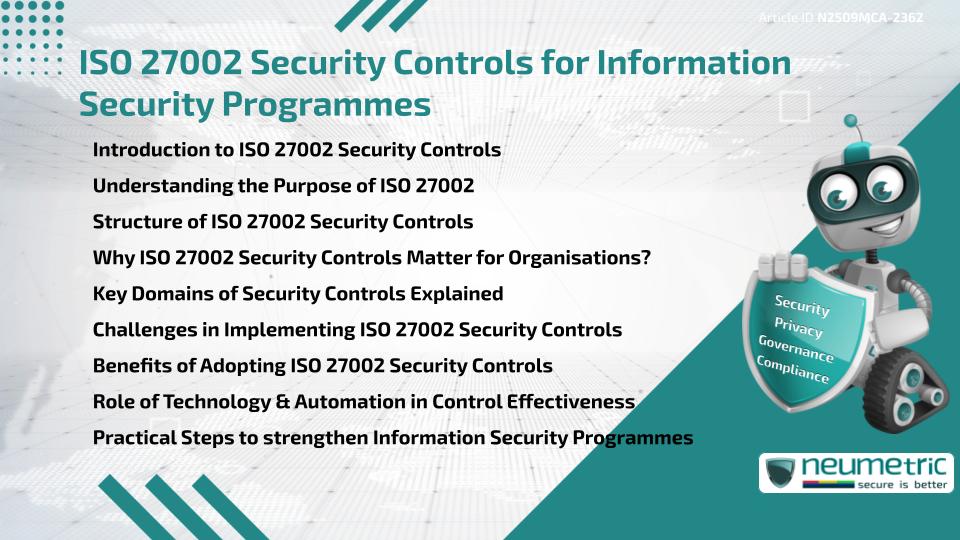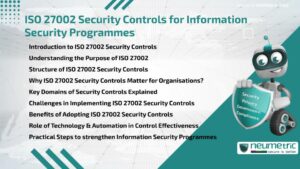Table of Contents
ToggleIntroduction to ISO 27002 Security Controls
ISO 27002 Security Controls provide detailed guidance for organisations to strengthen their Information Security programmes. Unlike ISO 27001, which sets requirements for Certification, ISO 27002 offers Best Practices & a catalogue of Controls to support Security Objectives. These Controls serve as a foundation for protecting Sensitive Information, aligning with Global Standards & building Trust with Stakeholders.
Understanding the Purpose of ISO 27002
The primary purpose of ISO 27002 is to provide a practical reference for organisations implementing an Information Security Management System [ISMS]. While ISO 27001 specifies “what” must be achieved, ISO 27002 explains “how” it can be achieved. It covers technical, organisational & procedural aspects of security, making it a vital tool for both Compliance & Operational effectiveness.
Structure of ISO 27002 Security Controls
The ISO 27002 Security Controls are organised into domains that address different aspects of Information Security. Each control includes objectives, implementation guidance & references to applicable standards. The Framework ensures that organisations can adapt controls to their specific context, whether they manage small-scale systems or complex, global infrastructures.
Why ISO 27002 Security Controls Matter for Organisations?
Organisations today face increasing Risks from Cyberattacks, insider Threats & Regulatory demands. ISO 27002 Security Controls provide a structured approach to mitigating these Risks. By implementing these Controls, businesses demonstrate commitment to safeguarding Information assets, which is vital for Compliance, Client Trust & long-term Resilience. Without structured Controls, security programmes Risk being reactive rather than proactive.
Key Domains of Security Controls Explained
The ISO 27002 Security Controls are grouped into several domains, including:
- Information Security Policies: Establishing clear & enforceable Policies.
- Organisation of Information Security: Defining roles & responsibilities.
- Human Resource Security: Ensuring Employees understand their security obligations.
- Access Control: Restricting access to information on a need-to-know basis.
- Cryptography: Applying strong Encryption to protect Sensitive Data.
- Physical & Environmental Security: Securing premises & equipment.
- Operations Security: Protecting systems & networks through Monitoring & Controls.
- Supplier Relationships: Managing Risks from Third Party service providers.
- Incident Management: Establishing Protocols for responding to security events.
Each domain supports a specific layer of protection, ensuring comprehensive coverage of organisational Risks.
Challenges in Implementing ISO 27002 Security Controls
While the Framework is comprehensive, implementation poses challenges. Small organisations may struggle with limited resources, while larger entities often face difficulties in aligning global operations under one set of Controls. Resistance to cultural change & lack of staff awareness are also common hurdles. Overcoming these requires leadership support, phased implementation & Continuous Training.
Benefits of Adopting ISO 27002 Security Controls
Adopting ISO 27002 Security Controls provides significant benefits, including improved Risk Management, enhanced Compliance with Regulatory requirements & increased Customer Trust. These Controls also create operational efficiencies by standardising processes & reducing duplication of effort. In industries where Security is a market differentiator, implementing ISO 27002 becomes a competitive advantage.
Role of Technology & Automation in Control Effectiveness
Technology & automation play a vital role in the effectiveness of ISO 27002 Security Controls. Automated Monitoring Tools help track Compliance with access Policies, detect unusual activity & ensure timely Incident Response. Documentation systems streamline Audits by keeping records updated. While automation reduces manual effort, human oversight remains essential to interpret data & make informed decisions.
Practical Steps to strengthen Information Security Programmes
Organisations seeking to strengthen their security programmes with ISO 27002 Security Controls can take practical steps such as:
- Conducting a Gap Analysis to identify missing Controls.
- Prioritising Controls based on Risk Assessments.
- Integrating Control Implementation with existing ISMS processes.
- Training staff regularly on Security Practices.
- Using automation to support Monitoring & Reporting.
These steps ensure that controls are not only implemented but also sustained over time.
Conclusion
ISO 27002 Security Controls provide organisations with a structured, adaptable & globally recognised Framework for securing information assets. By addressing technical, organisational & human factors, they help build resilient security programmes that go beyond Compliance.
Takeaways
- ISO 27002 Security Controls provide best-practice guidance for ISMS implementation.
- They cover a broad range of domains, from Access Control to supplier management.
- Challenges include resource limitations & cultural resistance.
- Benefits include improved Risk Management, Compliance & Customer Trust.
- Automation strengthens Control effectiveness but requires human oversight.
FAQ
What are ISO 27002 Security Controls?
They are best-practice guidelines that support organisations in implementing effective Information Security Measures.
How do ISO 27001 & ISO 27002 differ?
ISO 27001 defines Certification requirements, while ISO 27002 provides practical guidance & control objectives.
Why are ISO 27002 Security Controls important?
They help organisations reduce Risks, comply with Regulations & improve Information Security programmes.
Can Small Businesses implement ISO 27002 Security Controls?
Yes, the Framework is scalable, allowing smaller organisations to adopt Controls based on their Risk profile & resources.
How often should ISO 27002 Security Controls be reviewed?
Controls should be reviewed regularly, ideally at least once a year or when significant changes occur in the organisation.
What role does automation play in ISO 27002 Security Controls?
Automation supports Monitoring, Reporting & Compliance tracking, making Controls more effective & less resource-intensive.
Do ISO 27002 Security Controls apply to Third Party vendors?
Yes, Controls include supplier relationship management to address Risks from Third Party service providers.
Need help for Security, Privacy, Governance & VAPT?
Neumetric provides organisations the necessary help to achieve their Cybersecurity, Compliance, Governance, Privacy, Certifications & Pentesting needs.
Organisations & Businesses, specifically those which provide SaaS & AI Solutions in the Fintech, BFSI & other regulated sectors, usually need a Cybersecurity Partner for meeting & maintaining the ongoing Security & Privacy needs & requirements of their Enterprise Clients & Privacy conscious Customers.
SOC 2, ISO 27001, ISO 42001, NIST, HIPAA, HECVAT, EU GDPR are some of the Frameworks that are served by Fusion – a SaaS, multimodular, multitenant, centralised, automated, Cybersecurity & Compliance Management system.
Neumetric also provides Expert Services for technical security which covers VAPT for Web Applications, APIs, iOS & Android Mobile Apps, Security Testing for AWS & other Cloud Environments & Cloud Infrastructure & other similar scopes.
Reach out to us by Email or filling out the Contact Form…





